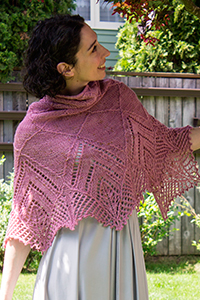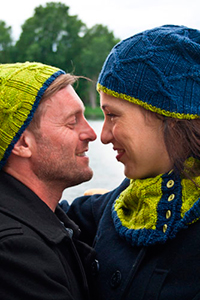 Shannon Okey's new book, The Knitgrrl guide to Professional Knitwear Design, is available and if you aren't already hearing some of the buzz, well, you don't spend as much time online as I do. Search around and you'll find plenty of high praise for good reason. This little treasure is a comprehensive look at how knitwear design happens; good, bad and everything in between. For designers and aspiring designers alike, there are tips, tricks and insightful interviews to more than cover the cost of admission and for those of you with no intention of ever designing but who love to see what happens behind the scenes, this book delivers there too.
Shannon Okey's new book, The Knitgrrl guide to Professional Knitwear Design, is available and if you aren't already hearing some of the buzz, well, you don't spend as much time online as I do. Search around and you'll find plenty of high praise for good reason. This little treasure is a comprehensive look at how knitwear design happens; good, bad and everything in between. For designers and aspiring designers alike, there are tips, tricks and insightful interviews to more than cover the cost of admission and for those of you with no intention of ever designing but who love to see what happens behind the scenes, this book delivers there too.
So are you dying to crack open this book? Shannon has graciously offered a copy to one lucky winner and since the last contest was so much fun, I thought I'd carry on the theme. Details at the end of the post!
But before that, I wanted to throw a few questions Shannon's way.
Marnie MacLean [MM]: This book is broken up into two broad sections; the informational part which is based on a lot of your personal experience as well as some input from other people in the industry, and then an interview section in which you talk to a great range of individuals in the industry. Did you have any big “AHA” moments from the interviews that shaped the way you wrote the first section of the book?
Shannon Okey [SO] :Most of the first portion of the book was written before the interviews took place, and is based on both my experience and observation, so there weren't any "AHA" moments so much as "mmmhmm, mmmhmm" when someone confirmed something I'd been thinking or had said.
MM: Have you made any changes to the way you run your business based on what you learned creating this book? And if so, what?
SO: I have, very slowly, come to the realization that it is OK to ask for help, and more specifically, to hand off things you don't like as much or aren't as good at doing to someone who is. It frees up more time to do what you love more. So, for example, I don't particularly like to grade patterns, and I am NOT a tech editor by any stretch of the imagination. I would rather hire someone who loves the math aspect, who delights in being nitpicky and crossing all the t's. Karin Strom's interview answers really made me feel better about doing this. I always felt that I SHOULD do every single bit of work on my patterns in order to be a "real" designer, but you know what? Karl Lagerfeld's not out there hemming dresses. The "petites mains" (specialist stitchers for the big couture houses) all have very specific skills, whether it's beading or stitching or whatever. They're not expected to do everything themselves: why should I? And with the exception of summertime, when I'm fortunate enough to have TNNA interns most years, I'm a one-woman show! So with all that in mind, I've come to accept that doing this will let me design more, not less, and make a better income for myself. I'm stubborn -- it took a while to convince myself this was ok!
MM: This book is so current that it has stats from a couple months ago which makes sense, because the industry is in such flux that what was true a year ago may be irrelevant now. What do you see for the future of this book? Do you imagine releasing updated versions every few years keeping what’s relevant and ditching what’s not?
SO: With the state of both the knitting and the publishing industries being what they are, who KNOWS what's going to happen a few months from now, let alone a few years? One of my projects this week was looking at online subscription-based models (akin to the ones some knitting magazines are using to make their titles available on the web), and thinking about how that might work for craft books, too. O'Reilly and technical publishers have already caught on to this -- tech books tend to have a very short shelf life, and being able to subscribe to the book on a virtual bookshelf makes more sense than spending $20-40 on a dead tree version. If you only like ONE pattern in a book, you're not going to buy the book, but you might be willing to pay $x to have access to the book for a short period of time, or to have access to just that pattern.
Two things we're looking at here at Cooperative Press (and by "we" I mean "royal we + anyone I draft in to help," such as my dear boyfriend, who did the typography on this book's cover) are the subscription model discussed above and also custom publishing. You, the end user, would be able to select specific chapters, sections or content from our books and blend them all together into an on-demand PDF or print book. It's not a new idea: one of the old school internet-gold-rush companies was doing this for travel books 10+ years ago at Booktailor.com. It's a question of applying the right technology and the right pricing to the model.
Also, I need to learn to keep my mouth shut. Someone else with deeper pockets than me will probably run right out and do both of those things. You heard it here first, kids. (Though the one advantage of DIY is that you can usually move faster than the people copying your ideas can!)
MM: Ok, so for our contest, I’m going to be carrying on the embarrassment theme from my last giveaway. To close off this interview, would you be willing to share a most embarrassing / head-deskery type moment from your crafting/authoring career?
SO: The knit-burqa. Oh man. I was doing a pattern for the Harry Potter knitting book (Charmed Knits). It was a knitting bag for Hermione. I'm a very experienced felter, and I should have known better. Imagine knitting a giant tube of Cascade 220. A tube so big (and black, for that matter) that I could fit inside it. I am 5'7" and I am NOT SMALL. So we started calling it the "knit burqa," that's what it looked like. I was SO HAPPY to have the damn thing finished that I resolved to march right down to the washer and felt it immediately. Never mind it's late and I'm exhausted. Never mind machine felting probably wasn't a superfabulous idea. I wanted it DONE done right this very moment. You can guess what happened, and it wasn't pretty. I had to cut it up in order to make it resemble my original plans and reverse-engineer the written pattern to suit. Doesn't matter how good you USUALLY are...doing anything that nearly destroys months of knitting in less than 30 minutes is not just head-deskery, it's earthshatteringly dumb.
MM: Thanks so much Shannon and thank you for including me in your book. It’s been a real pleasure.
Contest Rules
Leave a comment with some face-palming, head-desking, foot-in-mouthing embarrassing moment you don't mind sharing with the world. I will pick one person at random, so even if you can't recall one, you have an equal chance at winning if you leave a comment. But where's the fun in that? Comments must be sent by end of day on Thursday, July 15 and I will pick one random winner to receive a print copy of Shannon Okey's The Knitgrrl guide to Professional Knitwear Design.
And in the spirit of good sportsmanship, I'll share one of my many many embarrassing moments in life. I was, perhaps, 14, I lived in a small New Hampshire town, where everyone knew just about everyone. There was one boy, we'll call him George since I don't recall and Georges from my grade. I had a fantastically unrequited crush on him. I was walking around the drug store picking up a few things, when I realized he was in the store with me. I gave him an enthusiastic wave, a giant smile and called his name. He turned and looked at me, with a polite smile and then vague discomfort, which is the moment I realized that in my happily swaying hand, straight above my head, was the box of tampons I had just picked up. Go me!
To order copies of the book, you can go here. And be sure to follow Shannon's entire blog tour by visiting her site and checking the blog tour sidebar.





